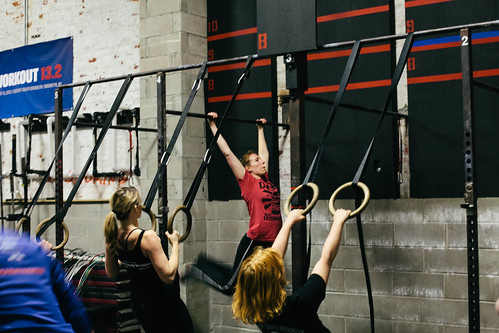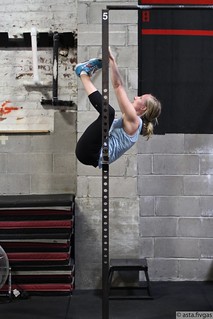
In the summer of 2012, we modified our group class programming format to include two levels of participation. We adopted this concept from several other CrossFit affiliates that had already started offering similar programming, and we implemented it out of our desire to best serve all our members. Almost immediately, we found that leveled options actually made both writing workouts and running classes much easier. In another post, I’ll discuss how we actually write and come up with the programming at CFSBK, but in this article, I’ll talk about our execution of this type of programming and underscore some of the benefits.
Scaling Versus Leveled Programming
I define scaling as a modification of components of an individual workout in order to preserve the intended stimulus of the Rx'd version. This might include decreasing the load or overall volume of the workout and substituting or assisting particular exercises. During group classes at an affiliate that serves the general population, scaling happens daily, in every workout, for most people. As an alternative, leveled programming takes a more long-term perspective and considers the needs, abilities, and training age of your members. It is essentially "scaling" on a macro level. At CFSBK, we use the common labels of Fitness and Performance to broadly describe our two levels of programming.
The Difference Between Fitness and Performance
Fitness programming is designed for all members between zero and six-plus months worth of consistent training at our gym, as well as intermediate athletes who find the Fitness workouts to be better in line with their capacities and goals. Performance workouts are designed for individuals who have spent several months to years developing a solid foundation and are interested in pushing the envelope of their performance and capacity in CrossFit. “Susan,” fresh out of Foundations, should default to Fitness programming, along with your most veteran member, "Al,” since he's a little overweight, has a temperamental back, and is more interested in keeping up with his kids than training like Rich Froning. Performance programming provides exposure to advanced movements and more demanding workouts, and is appropriate for athletes who are close to Rx-ing or can Rx most workouts.
Of course, everyone won't fit neatly into either category in every way, but having defined levels both helps most of your members and coaches define their training goals, and provides some broader options for full participation at your gym.
 Katie warming up her high bar back squatsBarbell Training
Katie warming up her high bar back squatsBarbell Training
On the slow lifts (squats, deadlifts, bench press, press), we program basic linear progressions (LP) every cycle for our Fitness athletes. Early in training, athletes are encouraged to find a modest starting weight or continue from a previous cycle's loads. Technique permitting, every week they try and add a conservative amount of weight from the previous exposure until they fully exhaust their LP. Only then should an athlete consider Performance level barbell lifting. New athletes should never be attempting maximal effort lifting. I shouldn’t be the first person telling you this, but serious rep max testing of any lift only happens after several months of dedicated exposure to the lifts and consistent and correct execution at submaximal weights. You're going to scare a lot of good people away if you attempt to put them in inappropriate training situations.
So, below is what a typical squat day might look like for Fitness folks at CFSBK:
Low Bar Back Squat
3-4 Ascending warm-up sets
3x5 work sets across
Add 5lbs from last week's numbers. This is LBBSQ exposure 3 of 10 this cycle.
Performance athletes follow more intermediate-level programming, which might include percentage work, volume and intensity days, rep outs, and occasional rep max testing. Their programming might look like:
Low Bar Back Squat
3-4 Ascending Warm-Ups
75% x 5
85% x 3
95% x 1+
Remember to base these %s off your “training max” not your true max. Next week we’ll deload then reset.
Novice training is generally boring—in the sense that there is more consistency in rep and set schemes, and we’re simply trying to build a base of strength and technique—so you don't hear much about it. Intermediate programming is a lot sexier to talk about and there is no shortage of productive methods that can be found around the internet (go here, here, and here, for examples). In short, long-term athletes require more nuanced programming in order to continue to push their numbers up.
For the Olympic lifts (snatch and clean and jerk), we'll often modify how the movement is segmented in order to help teach proper positioning in these more technical and dynamic lifts. For example, on a clean and jerk day, the fitness version might be written as such:
Take 15 Minutes to find a heavy but perfect single of:
Clean Deadlift to Mid Hang + Hang Power Clean + Front Squat + Push Press or Jerk
This segmentation within the fitness programming allows people to break apart the lifts into sizable chunks and ingrain proper positions before attempting to execute the lifts in full. We can also make considerations for movement restrictions; say one of your members can't front squat below parallel without caving their upper back and dropping their elbows. You can have them remove the front squat portion and train just the power clean, which might be their deepest stable position. Similarly, snatches can easily be programmed to start above the knee if a correct starting position can't be obtained. The athlete knows that they'll have to stop and reorganize themselves at the mid hang before attempting a dynamic pull.  Eric working his clean starting from the knee
Eric working his clean starting from the knee
Performance level athletes will often perform the full versions of the movements with sequencing that inherently requires masterful execution of the basic lift. Their clean and jerk day might look like:
Take 15 Minutes to find a heavy but perfect single of:
Power Clean + Hang Squat Clean + Split Jerk
WODs
We don't always split up the WODs by Fitness and Performance designations. Depending on the workout, often some simple scaling can be applied and work easily for all levels. Other times, it might be more appropriate to designate the levels, especially if you want to simplify the scaling options and include a movement that many people in your gym won't be able to do. For example:
3 Rounds for Time of:
Performance
Run 400m
5 Muscle-Ups
10 Deadlifts 225/155
Fitness
Run 400m
15 Burpees
10 Deadlifts
The burpees aren’t meant to develop the attributes that would bring someone closer to a muscle-up, but many people will never perform a muscle-up and won't get much out of doing an overscaled version of one. Instead, by programming burpees for Fitness folks, we preserve the metabolic stimulus and save a bunch of time not having to set up 20 ring stations with a bunch of bands and monitor people who can't even do a ring support, yet are attempting to organize an entire muscle-up sequence. You might think that your members would push back on this, but I promise they won’t. They'll appreciate doing something simply hard rather than doing something that ends up either being too hard, too easy, or just awkward and frustrating to organize in a timed setting.
Below is another example of a leveled WOD, and in this case, people will be able to see quickly which version they'll be able to get the most out of.
AMRAP 12 Minutes:
Performance
Row 300 meters
10 Kipping Pull-Ups
10 Overhead Squats 115/75
Fitness
Row 300 meters
10 Ring Rows or 5 Strict Pull-Ups
10 Front Squats
These two versions have clear designations between volume in kipping pull-ups, strict pull-ups, and ring rows, as well as a comparable sub for people who may not be able to organize 30 overhead squats at any significant weight. I’d rather someone front squat 95lbs for reps than crumble while attempting to overhead squat a 65lb barbell.
Generally speaking, Fitness WODs often require fewer skills and are less ballistic versions of the performance WODs. We can easily write a version that ends up being systemically more challenging for the athlete and requires much less set-up, coaching, and modification, instead of attempting to scale more advanced or demanding movements.
Final Thoughts
Two final points about leveled programming: First, it's common also to see a "competition" level programmed at some affiliates. My general opinion is that about 95% of the people who train at CrossFit gyms are going to fit within the categories of Fitness and Performance, and adding a third level is probably best left to specialized classes instead of programming those workouts for your general population. Furthermore, we’ve found that the Performance level programming is often plenty potent for even our best athletes. And really, I think having a third distinct level of programming would be a pain in the ass to execute as a coach. Second, it’s worth mentioning that leveled classes are not a substitute for a good Foundations program, since the Fitness level still requires a basic introduction to performing the lifts and movements well.
 I’ll leave you with thoughts from a couple of our members (who have been with us for years and experienced the change in 2012) regarding what they appreciate about leveled programming.
I’ll leave you with thoughts from a couple of our members (who have been with us for years and experienced the change in 2012) regarding what they appreciate about leveled programming.
“As somebody who straddles the lines between these two options constantly, I liked the change a lot when it happened, and still do. It made scaling and challenging yourself much easier, and it seemed to make the coaches’ jobs much easier, with much less time spent on helping people figure out scaling options. Classes got big and with a huge variety of skill levels, it seemed to allow more focus. I try to do performance as much as possible, but don't feel bound to do one or the other in any given class. I just try to stick with one level during a cycle intra-movement, even if not intermovement.”
—Joel W.
“I've been doing CrossFit for 3 years now, but there's still a place in my training for both Fitness and Performance options. I'm better at pure strength movements like the power lifts than I am at high-skill movements like Olympic lifts and kipping pull-ups, so when the workout is strength biased I will choose the Performance version. This helps me extract more progress out of myself even at lifts where my 1RM PR really does represent my maximal capacity. But when I am less experienced or less skilled at a movement, I don't consider it "stepping back" to do the Fitness programming—I am either working on my skills or increasing my work capacity in bigger jumps because I have further to go. Fitness is also great for recovering from an injury—when I tweaked my lower back a couple of months ago, I used the Fitness programming for front and high bar back squatting to start at an appropriate place and add weight week by week. And now I'm squatting more than I did when I injured myself, safely!”
—Stella Z.
_______________________
What do you think about leveled programming at CrossFit affiliates?